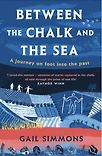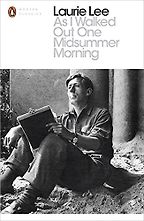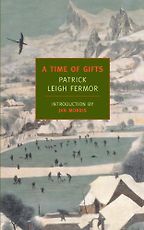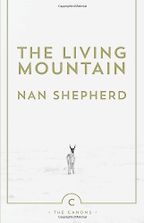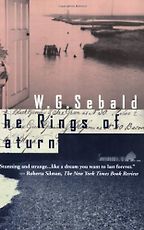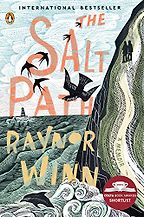Let me start our discussion by noting that when we settled on ‘hiking memoirs’ as a theme, I was surprised by how many there are out there. Why do journeys on foot make for such effective and popular narratives?
That’s a good question. There are lots of reasons. Seeing the landscape on foot is very different to seeing it while traveling by any other means, even on a bike. Walking is the ultimate in slow travel, and therefore in immersive travel. With books about walking, you really feel like you are traveling in the company of that person, you are with them every step of the way. And I also think there’s something about the rhythm of walking that makes the words come in a way that sitting at a computer doesn’t. I write while walking by dictating into a voice recorder. I don’t take a notebook as that means stopping the rhythm. I find the words come, and I transcribe them when I get home. There is a deep connection in the body between the feet, the heartbeat, and the words that come out. If you’re writing stuff down in a notebook, there’s another layer that to me filters out the direct experience.
So I think, as a reader, hiking memoirs appeal because they are immersive. And as a writer, walking and writing go together.
I recently revisited Rebecca Solnit’s Wanderlust: The History of Walking. She argues that walking frees up or loosens one’s way of thinking. In Between the Chalk and Sea, you’ve written about an old pilgrimage route in England, and I suppose pilgrimage is also tied up in the notion of walking as an act of reflection. Would you agree with that?
Absolutely. Yes, that’s a terrific book. And it’s absolutely the case that there’s something about walking that frees the mind. If you are sitting talking to someone, trying to hammer out a problem around a table, it might never happen. Go for a walk with them and it does. The mind and the body are not two separate things. They go together. Free the body, and you free the mind.
You mentioned the old pilgrimage route I walked. I guess for people in the Middle Ages—and I’m talking about the UK here, because pilgrimage was banned by Henry VIII, so although it’s been revitalised in the last century the practice died out for hundreds of years—it was one of the only excuses people had to travel, particularly for women. Men might travel as merchants or soldiers, but women really couldn’t. So pilgrimage was the only chance to get out of the strictures of a normal domestic life.
Many pilgrims traveled by horse if they could afford it—like Chaucer’s Wife of Bath, who was of the mercantile class—but poor people couldn’t, they had to walk. They’d walk out of their village, setting off on a journey without knowing when, or even if, they’d come back. It was exciting and liberating.
Quite recently I was trekking in a part of Nepal that, due to its climate and topology, will likely never be connected to a road network. It struck me how different the lifestyle was there to the average way of life in the west, or even urban Nepal. ‘Popping to the shops’ might take three days. Do you think the enjoyment of walking is something that has only come with development? Or was it always sewn into the experience?
It’s hard to tell, because of course one can’t get into the minds of other people. But I think, generally, it’s a post-industrial phenomenon. The first people to write about walking were the Romantics, such as Wordsworth.
Of course, this is a huge generalisation. We’re talking about millions of people throughout the centuries, and everyone’s different. But walking meant work for a lot of people; it meant going out into the fields, it meant labour and hard physical work. It wasn’t done for enjoyment, generally. But once people moved into towns more, and we became an industrialised society, then walking was a freedom from that.
“I write while walking by dictating into a voice recorder. I don’t take a notebook as that means stopping the rhythm”
I say a huge generalisation, because you’ve got people like John Clare, the ‘peasant poet’ of Northamptonshire, who was writing at about that time. He was a rural man but still enjoyed walking and exploring on foot for the sheer pleasure of it. And the philosopher Rousseau was writing about walking even earlier, in the eighteenth century in his Reveries of the Solitary Walker.
We’ve always walked, that’s how we get around. We are humans, we are made to walk, and we are meant to walk. One of the things that makes us human is moving on two legs. Once we became constrained to towns and to factories, separated from nature, walking meant getting back into nature again.
We agreed to step through your hiking memoir recommendations in chronological order. By my reckoning, that means starting with Laurie Lee’s As I Walked Out One Midsummer Morning.
It’s an interesting book, a young man’s coming-of-age classic. He’s a 20-year-old troubadour wandering through Spain, playing his fiddle for supper, enjoying the romance of it, and just in love with the freedom, with the road under his feet. And he just happens to walk into one of the most devastating civil wars of the 20th century.
The sheer exuberance of youth comes over in the book, and his vivid description of the landscape—the same intense description you get in Cider With Rosie, the first of his trilogy of memoirs. The prose feels as fresh and youthful as the day it was written. It’s like poetry to me.
The book was published in 1969, but he was walking in 1935. I’ve heard other people say, well, a lot of it was recreated, it’s written through the prism of memory. I don’t really think it’s an issue that some of it might not be as accurate as if he’d written it while he walked.
That’s an issue that dogs memoir as a genre generally, and travel writing too to an extent. No one has perfect recall.
These writers aren’t journalists. This is literature, after all. It’s a very northern European concept, to believe there is a clear division between fiction and nonfiction. There’s less of a divide in South America and southern Europe. It’s a false binary. After all, we all rely on memory to recall the past. We’re not taking notes about every incident of our lives. Some people keep diaries, I guess, but things we recall change in the recollection. That’s a reflection of reality.
What you’ve said there might also apply to Patrick Leigh Fermor’s trilogy of memoirs, beginning with A Time of Gifts, which was published in 1977—again, several decades after the walk it describes. It was followed by Between the Woods and the Water in 1986 and The Broken Road, which was published posthumously in 2013.
Yes, that’s a similarity with Laurie Lee. But Lee was a rural lad, brought up in virtual poverty. Leigh Fermor was from an upper-middle-class background. He had letters of introduction to some of the finest aristocratic houses in Europe. His is an interesting take on Europe on the eve of the disruption of World War Two. Reading these books now is like reading history—this is how Europe was pre-1939.
The final book in the trilogy, The Broken Road, was completed after he died by his biographer Artemis Cooper. It’s a very different book, a far more reflective book, about an older man recalling his more youthful self—which the previous books don’t have, because they were written earlier. The first two, interestingly, were written from memory, because his diary was stolen with his backpack from a hostel he was staying in. So they were recreated from memory, whereas the diary was returned to him later and The Broken Road was recreated from that diary. Does that make it a better book than the earlier two? I don’t know.
The books go together well. A Time of Gifts is like a Beaujolais Nouveau—very youthful and fresh. The last book is like an aged Burgundy— deepened, more reflective, and profound. Through those three books, we see someone’s life journey, from a young man to an old man; we see him evolve. He died at the age of 96.
Another interesting similarity between this and the Laurie Lee book is that they take place at a sort of tipping point in history. One does get a sense of why a journey on foot might be a good way to record social conditions; there’s a sense of cutting a cross-section through society, because you have to keep going through less notable places.
Yes, unless you cheat and take buses, you just have to take what comes. You encounter people from all different walks of life, who you wouldn’t do otherwise. I found this on my own walking journey; you place yourself at the mercy of people, rely on the kindness of strangers. That puts you in a vulnerable situation—you are vulnerable, particularly traveling on your own. But that means that you are opening yourself to encounters, and you get much more out of it in terms of material as a writer.
You mentioned women walkers. Should we talk about Nan Shepherd next? The Living Mountain is an interesting memoir of hiking, because it doesn’t record a single journey but rather an accumulation of journeys into the Cairngorms in the Scottish Highlands.
This book was written long before it was published. A draft was completed around 1945. She had written some fiction and poetry before. Neil Gunn was a mentor of hers, and she sent it to him. I think he said something like, this is really good but I’m not quite sure it should be published. So she stuck it in a drawer. It was finally published by Aberdeen University Press in 1977, and then reissued in 2011 with an introduction by Robert Macfarlane. Now it’s considered a minor classic alongside another half-forgotten book, J. A. Baker’s The Peregrine.
Nan Shepherd walked, not on a linear journey, but over a lifetime. She went ‘into’ the mountains, not onto them, so a very different approach to the view that mountains are there to be climbed and conquered.
She was probably quite an eccentric. She would swim naked, walk barefoot. She wanted to immerse herself in the landscape. She realised that striding out over the landscape for hours and hours was a liberating experience, even a metaphysical experience. So I do think that the book can be shoehorned into a list of hiking memoirs.
I agree. It’s a memoir that portrays a life’s-worth of hiking.
She lived to the age of 88, but her memoir was pushed away in a drawer. Now it’s a modern classic, even though it’s only novella-length—around 30,000 words. It shines like a highly polished diamond. It’s absolutely beautiful, and the more you read it the more you get out of it. I love books that you can read again and again, and still find something new in them.
Absolutely, there’s a lovely clarity to the book. Next, you’ve chosen The Rings of Saturn by W.G. Sebald. It’s sometimes classified as fiction, sometimes as memoir or essayistic nonfiction.
I think the key thing is to approach it without trying to think, what genre is this?
Right.
What’s interesting about this book is that it was published in German first, in 1995. Sebald’s books were first written in German, even though he taught at the University of East Anglia and was a citizen of Britain for a long time. And his books defied categorisation at a time when travel writing was the genre of the day, the way ‘New Nature Writing’ is reaching its peak today. Now, it’s a celebrated genre, the bookshelves are full of New Nature Writing. Robert Macfarlane, as you know, has been at the forefront of this.
Before that, in the mid- to late-20th century, it was travel writing. You had writers like Bruce Chatwin, Norman Lewis, Patrick Leigh Fermor, people like that. But as you got to the end of the 20th century, travel writing as a genre hit rock bottom. Chatwin was, like Macfarlane, a literary celebrity as well as a writer. I think he was less shy than Macfarlane, though.
Chatwin’s biographer Nicholas Shakespeare described him to us in an interview as ”a hopelessly impractical chatterbox who could not stop talking and never did the washing-up.”
He died in his late forties, from Aids, in 1989. After that, he started to be criticised because he made stuff up, embellished characters. People he wrote about objected to the way they’d been portrayed. He was vilified for not being accurate. Here we come back to this fiction/nonfiction thing. His book The Songlines was nominated for the Thomas Cook Travel Award, but he withdrew it because, he said, it was fictional.
Later you got people like Tony Hawks going around Ireland with a fridge…. It got ridiculous. Then, at the end of all this, you have Sebald writing The Rings of Saturn. Is it a travel book? Is it memoir? Is it fiction? Is it history? I mean, it’s everything. It’s a book about time, it’s a book about space. It is a book about walking. But it’s also much more than that; it’s a journey of the mind as well as a journey on foot. He was really a psychogeographer. He burst open this idea that travel writing had to fit into a neat category.
Just to clarify, for readers who haven’t come across The Rings of Saturn before: in it, Sebald walks around Suffolk in England, but the narrative constantly slips its harness to make digressions into questions of death, decline, and the ghosts that haunt the landscape. It has been very influential among writers of what we might now call ‘creative nonfiction’.
Right, he does describe the landscape, but all through the prism of his mood. He’s low, he’s been in hospital, he’s quite depressed. He talks about how feeling unwell colours his rather bleak view of the landscape. The weather’s not very nice. It’s not a conventional celebration of the landscape. But everything around him triggers a great journeying in his mind, which is absolutely fascinating. You’re journeying around his head, and his immense knowledge, more than you journey around the landscape.
The traditional travel narrative is a linear journey—an outward journey and an inner journey that takes place at the same time. In this case, the inner journey is more important than the outer journey.
That’s a good way to put it. Thanks. I think that brings us to Raynor Winn’s The Salt Path. This hiking memoir is quite a recent hit. Why so?
There are lots of reasons why I think it was a hit. It’s a story of jeopardy: of losing your home, and of potentially losing your life partner to terminal illness. Because so much is in the balance, it reads like a thriller. It’s a page-turner. And it’s so immersive you can taste the sea as you read it. And it has humour and tenderness.
It’s the sort of book that people who wouldn’t normally read travel or nature writing read. Recently I was taking proofs of my book around bookshops in southern England last week in anticipation of my book launch. I was in one Waterstones, talking to the bookshop owner, and this woman came up and said, ‘Your book sounds so interesting. I’m into nature writing now, because I read The Salt Path.’
Get the weekly Five Books newsletter
Again, this is a book that defies easy categorisation. It’s travel, nature, memoir. It was shortlisted for the Costa Biography Award, shortlisted for the Wainwright Prize for nature writing and it won the Royal Society of Literature’s Christopher Bland Prize for first authors over 50. It’s an inversion of the traditional quest narrative, because The Salt Path is about two people in a desperate situation, with nowhere to go. They’re on an anti-quest—they’ve just got to go, whether they want to or not.
At the start of the book, Winn and her husband Moth are made homeless, and he is diagnosed with a rare, degenerative illness.
If you had to make the elevator pitch, you’d say: in the same week, she lost her home, her business, and her husband. Moth is told by his doctor not to do anything strenuous—‘don’t climb stairs!’—but the bailiffs are knocking at the door. It sounds very high concept, but it’s real.
So they get their backpacks, Paddy Dillon’s walking guide to the 630-mile South West Coast Path, and they just walk. They’ve got nothing else to do. So the book is about finding home when you have no home. It’s about homelessness as well—how the homeless are treated. When they were walking, if people thought they were homeless, they’d be shunned. But if they changed the narrative and said, ‘we’ve sold our home and decided to go on a life-changing walk’, people would say, ‘how inspirational’. The same facts, but a different perception.
It’s funny and warm. And she didn’t write as she went along, she just made notes in the margins of Paddy Dillon’s guidebook. Then she wrote them up for Moth because he was losing his memory, and her daughter said, ‘Mum, you must do something with this, it’s good.’ Winn thought she meant bind it in a proper binder, but her daughter meant she should get it published. She sent it out, an agent got straight back, and Penguin published it. It’s like a dream come true.
I wonder if this comes back to something we touched on at the beginning of this conversation about the appeal of walking narratives. I do think that walking seems to be something people do when they are hitting rock bottom. I mean, it’s a low-budget method of travel. That helped Winn, but also writers like Cheryl Strayed, who walked the Pacific Crest Trail at a really low point in her life, which she wrote about in the mega-bestseller Wild—in which the physical journey is a metaphor for a more general redemption.
Cheryl Strayed is similar in many ways. She was reaching rock bottom because of drug addiction, and losing her mother. Readers live that kind of jeopardy vicariously, without having to live it themselves. So that’s part of the appeal. And that’s true of all great travel literature too—readers travel through the eyes of the author.
In her latest book, Raynor Winn walks the Cape Wrath Trail, and meets people who say they are there because they read some book by a woman called Raynor Winn—they don’t recognise her—and she doesn’t say, hey, that’s me. Her book has inspired people to walk, even though in The Salt Path she was walking because she had to, not through choice.
Those young men like Laurie Lee and Patrick Leigh Fermor didn’t have much money, but there’s less sense of jeopardy. But there is that same sense of freedom, in not needing very much to be able to do this—to walk out with a backpack, all your possessions on your back, and not needing anything else.
In my book, Will Parsons, who created the ‘Old Way’, is the guy who inspired me. I got to know about him years ago when he and two mates set out and walked around Britain with just their backpacks—nowhere to go, nowhere to stay. They started singing to earn a bit of money, like medieval troubadours. They walked around the country for months. You can do that when you’re 20. When you’re older, it’s harder, you’ve got responsibilities. So seeing other people doing it makes you feel that freedom again.
Journeying on foot is as old as time. And people still like reading about it.
Interview by Cal Flyn, Deputy Editor
February 17, 2023. Updated: February 21, 2023
Five Books aims to keep its book recommendations and interviews up to date. If you are the interviewee and would like to update your choice of books (or even just what you say about them) please email us at [email protected]
Five Books interviews are expensive to produce. If you've enjoyed this interview, please support us by donating a small amount.

